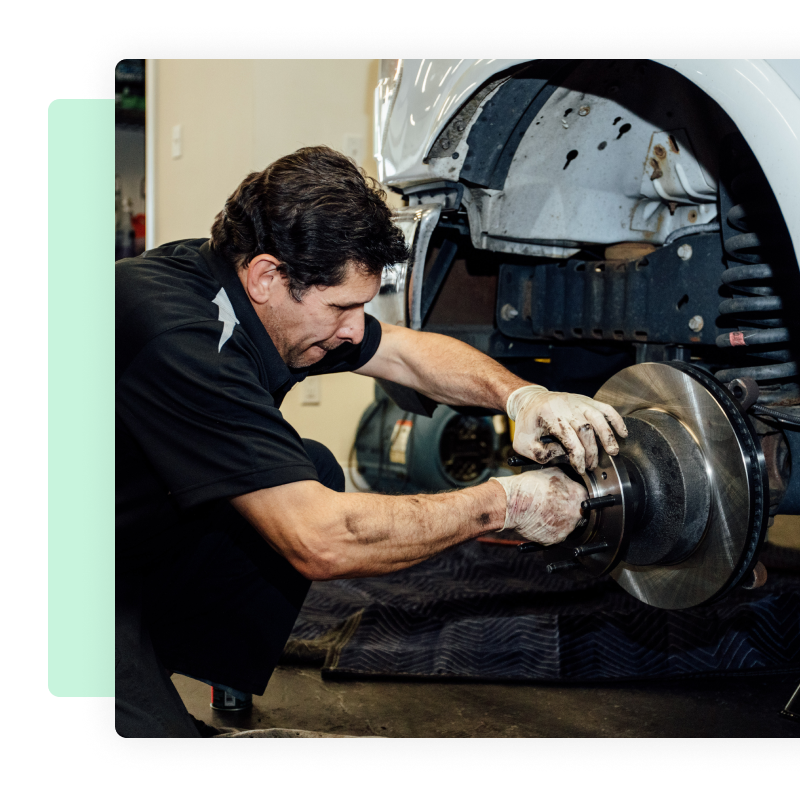3 Fleet Alignment Warning Signs to Fix Now
If your fleet’s fuel efficiency is slipping or tire replacements are piling up, misalignment may be to blame. Learn the 3 warning signs – pulling, wandering steering, uneven wear – and how to fix them for better safety, savings and uptime.
Jul 21, 2023 | Updated: Jun 24, 2025
8 min read

TL;DR: Why does tire alignment matter?
Misalignment silently drains fleet efficiency and safety. Watch for pulling, wandering steering, and uneven tire wear - all early warning signs.
Why alignment matters
Poor wheel alignment shortens tire life, increases fuel costs, and adds risk for your drivers. Even small issues can reduce MPG and inflate total cost of ownership.
Common signs of misalignment:
- Vehicle pulls to one side - often caused by incorrect camber angles.
- Loose or wandering steering - usually tied to toe or caster misalignment.
- Uneven tire wear - especially on the inner or outer edges, indicating camber or toe issues.
Proactive steps to take:
- Add alignments to your PM schedule
- Train drivers to report early symptoms
- Track tire wear patterns with software
- Use digital inspections to catch issues early
The fix? Stay proactive. A fleet management system like Fleetio helps track alignment needs, reduce tire costs and maximize uptime.
If you've ever wondered why your fleet is burning through tires or mileage is dropping, misalignment could be the culprit. Tire misalignment is a small but mighty facet of fleet maintenance that can wreak havoc on your assets if left unchecked, but if you prioritize it properly, you can save a good chunk of change and add thousands of miles to your average tire life.
What is alignment?
A car’s alignment refers to how the angles of the wheels are adjusted. When a technician or fleet repair shop performs an alignment, they adjust the angle of the wheels to the manufacturer’s specification or the range allowed. Proper alignment is of utmost importance when it comes to keeping your assets properly maintained and optimized for cost and performance.
The cost of misalignment is high: according to the National Highway Traffic Safety Administration, 646 people died in tire-related road fatalities in 2023. But when you place importance on tire health, it can not only secure driver safety, but add nearly 4,700 miles to tire life and save around $0.11 per gallon on fuel.
Common causes of misalignment in fleet vehicles
You can't entirely avoid misalignment. Tires will naturally get knocked out of alignment due to a handful of different road conditions, for reasons like:
- Driving over potholes
- Hitting curbs or road debris
- Minor vehicle collisions
- Bad shocks, struts or other suspension parts
Alignment can be affected by a single big event, like an accident, or by an accumulation of totally normal driving incidents, like a year's worth of potholes and one good curb hit. That’s why it’s important to include realignments on a regular interval in your vehicle preventive maintenance plans.
Consequences of tire misalignment
Misaligned tire and wheel assemblies can have a big impact down the line. Your tires can wear out faster, which at best means you have to purchase new tires more frequently and at worst potential accidents due to a blowout on the road and associated insurance costs. Slight misalignments can also negatively impact your gas mileage, which artificially inflates your gas costs and cost per mile on your vehicles.
The good news is that strict preventive maintenance compliance can help you avoid any of the pitfalls of misalignment, allowing you to align your wheels regularly and ensure proper alignment. But sometimes, road conditions or driving behavior can impact your alignment before you get the opportunity to get a vehicle in for scheduled preventive maintenance.
Want to save on tire costs and keep drivers safe? Here’s how to spot misalignment early.
Is your rubber really meeting the road?
Misalignment starts small, but it hits hard — wasting fuel, wrecking tires and wreaking havoc on fleet costs. With Fleetio, you can track tire wear, spot issues early and cut costs at every turn of the wheel.
See tire management tools3 major signs of tire misalignment
Quick alignment symptom guide
Compare fleet vehicle wheel alignment signs with likely causes and solutions. Ideal for tech inspections and maintenance planning.
| Symptom | Likely Cause | Corrective Action |
|---|---|---|
| Vehicle pulls to one side while driving | Uneven camber angle or worn suspension components | Schedule a professional alignment and inspect suspension for wear |
| Steering wheel feels loose or drifts | Toe misalignment or loose steering linkage | Perform alignment and check steering components for play |
| Steering wheel is off-center | Incorrect alignment or bent components | Re-center wheel and perform full alignment |
| Steering vibration at speed | Wheel imbalance or misaligned suspension | Balance tires and check alignment geometry |
| Uneven tire wear | Camber/toe misalignment from potholes or overloading | Rotate tires, check alignment angles, and realign |
Pulling to one side while driving
If your asset drifts toward the shoulder or the center line without steering input, there’s likely an alignment issue. This constant “pull” forces the driver to compensate, adding strain and increasing risk. The root cause is often incorrect camber, which refers to the inward or outward tilt of a wheel when viewed from the front. Even slight camber misalignment can shift the vehicle’s balance and make it difficult to track straight.
Pro-Tip
Pulling is one of the earliest and most noticeable symptoms of misalignment. Addressing it promptly can help preserve fuel efficiency and avoid driver fatigue.
Wandering or loose steering
In addition to pulling, drivers may notice “wandering” behavior, where the steering feels loose or the asset doesn’t maintain its lane easily. This can be caused by a caster angle that’s too far forward (positive caster) or inconsistencies in the toe alignment. Caster is the angle of the steering pivot when viewed from the side, and when off-spec, it creates an unstable or overly stiff steering feel.
Quick Check
If drivers frequently over-correct or feel they’re “fighting the wheel,” it’s time for an alignment inspection.
Uneven tire wear: inside or outside tread patterns
Uneven tire wear is a telltale sign of poor alignment, especially when wear appears on just the inside or outside edge of the tread. For example:
- Outside edge wear often points to excessive toe-in or positive camber
- Inside edge wear may indicate toe-out or negative camber
When alignment angles like toe or camber are off, tires scrub across the pavement instead of rolling smoothly. This reduces tire lifespan and can compromise safety.
Fleet Insight
Tracking wear patterns over time can help your team proactively spot alignment issues before they impact total cost of ownership (TCO).
Common misconceptions on wheel alignment
Many fleets overlook alignment issues or delay addressing them because of a few common misunderstandings. Let’s clear those up:
“If the tires look fine, alignment must be fine.”
Tire wear can take time to show visually. Even small alignment issues can silently reduce fuel efficiency and increase driver fatigue before tread wear appears.
“We just had new tires installed, so alignment was included.”
Tire replacement and alignment are often separate services. Always confirm an alignment check was performed, and request the spec sheet if possible.
“Our drivers would report if something felt off.”
Not all alignment issues are immediately noticeable behind the wheel, especially if they develop gradually. Proactive inspections are more reliable than reactive reports.
“Alignment isn’t as urgent as oil changes or brake work.”
Misalignment can accelerate tire wear, reduce MPG, and cause suspension strain, leading to preventable downtime and higher total cost of ownership (TCO).
How fleet optimization software can help
Regularly inspecting tires is a great item to include on daily pre-trip inspections and can help tip you off to any issues with alignment. Using a fleet maintenance app like Fleetio can make that process even simpler, with digital inspection forms that can be completed from drivers’ phones or tablets and automated work orders. You can even add alignment tasks to each asset’s individual PM schedule so you never miss an alignment.
Align more than tires — your whole fleet
Bring your team, data and entire maintenance process together in one platform. See everything. Control costs. Keep your fleet moving. One quick demo could mean the difference.
Book a time that works for youFAQs
How do I know if my fleet vehicle needs a wheel alignment?
Look for signs like pulling to one side, wandering steering, uneven tire wear or a steering wheel that’s off-center. Regular inspections and driver reports can help catch issues early.
How often should fleet vehicles get a wheel alignment?
Most fleets benefit from alignment checks at least once a year or every 12,000–15,000 miles. Vehicles in rough terrain, urban stop-and-go traffic or with heavy payloads may need more frequent checks.
Can poor alignment affect fuel efficiency?
Yes – misaligned wheels increase rolling resistance, which can reduce fuel efficiency by up to 10%. This adds up quickly across high-mileage fleet vehicles.
What causes a vehicle’s alignment to go out?
Common causes include hitting potholes or curbs, worn suspension parts, overloading or aggressive driving conditions. Even small impacts can affect alignment angles over time.
Do I need an alignment if I just got new tires?
Yes – installing new tires doesn’t guarantee your alignment is correct. Skipping alignment can cause premature wear on the new tires, leading to higher long-term costs.

Senior Fleet Content Specialist
As a Senior Fleet Content Specialist at Fleetio, Peyton explores the voices and experiences that shape fleet operations. She focuses on how fleet professionals adopt technology, improve efficiency and lead their teams to bring clarity and context to the challenges happening across the industry.
View articles by Peyton Panik
Director of Fleet Content, Fleetio
Zach Searcy is the Senior Content Marketing Manager at Fleetio with more than 5 years of experience in the automotive and fleet industries. His content creation days started in middle school when he and his friends began filming lightsaber battles to upload to a new website: 'YouTube.'
LinkedIn|View articles by Zach SearcyReady to get started?
Join thousands of satisfied customers using Fleetio
Questions? Call us at 1-800-975-5304

